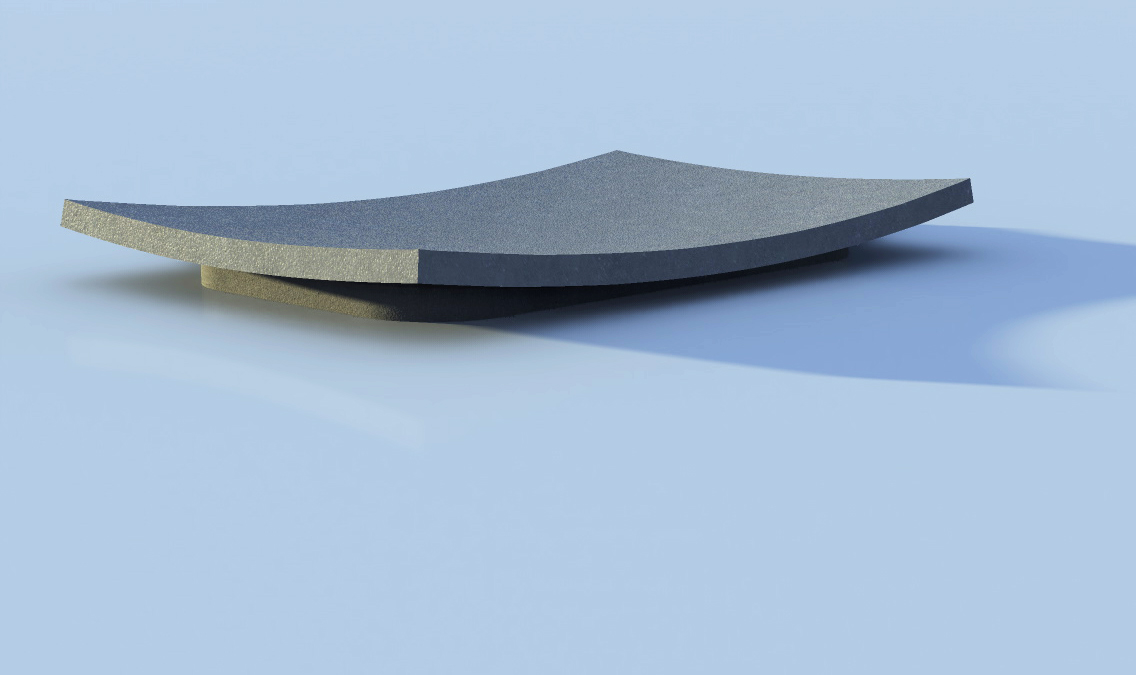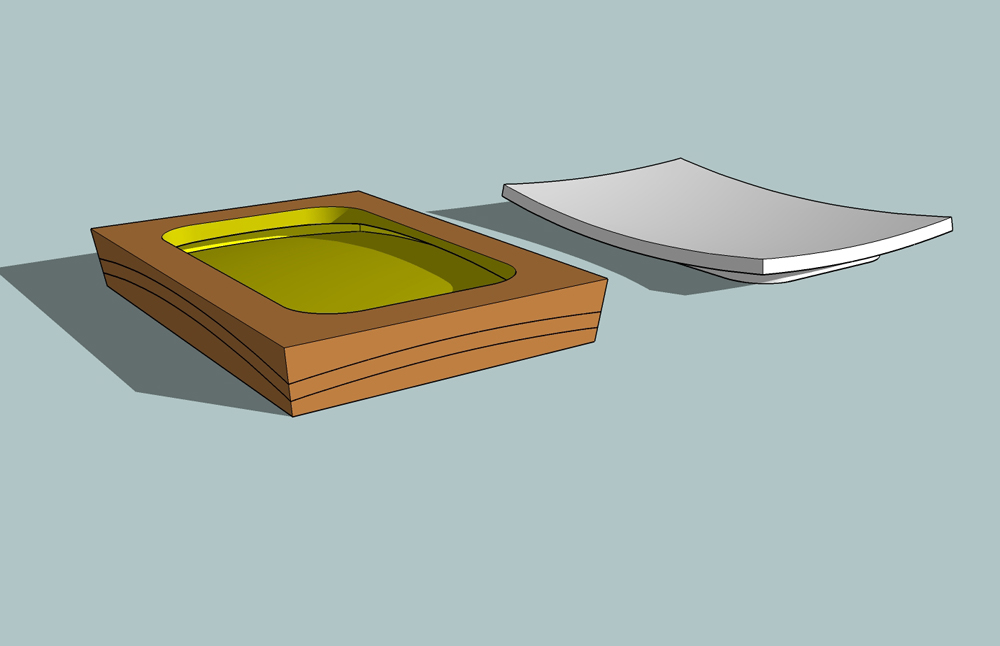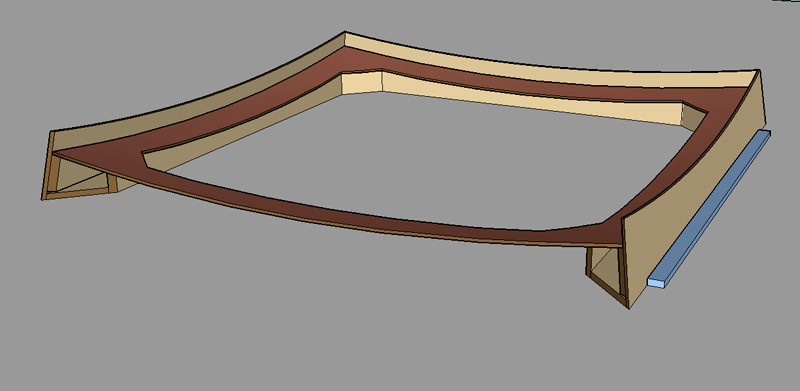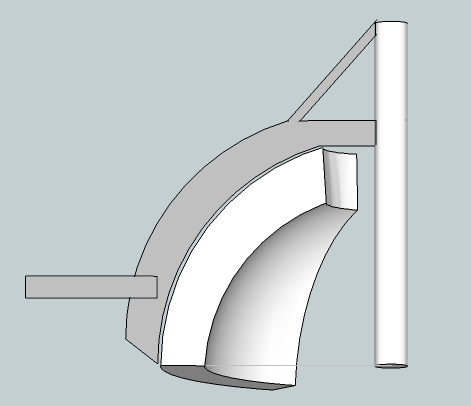Dome Model In Reality
-
Hi All
Before I begin, Mods could you move this topic to the right place if it is not already there. Thanks
As most of you know and some following closely, Gaieus has been helping me put together a model of a dome. I would love to say we’re complete but as Gaieus mentioned in one of his posts, you are always tweaking your design. Every time we complete a step, I look at the model in a totally different light with new ideas popping up all the time.
Never the less, now comes the next step in my model. That is, putting everything we’ve done on paper into reality. This is where I am requesting assistance from everyone in the forum.
The reason I asked Gai to divide the dome into 6 equal parts was because I need to create a mould of each piece. Before even starting this model with Gai, I had several ideas which, believe me, seemed Childs play to do when thought out in my head but after each step of the model, I realized how mistaken I was and I’m glad that Gaieus was so kind enough to assist me which saved me from a costly disaster.
%(#FF4040)[Could you guys give me some ideas in creating a mould of each piece out of 6 pieces of the model?To me, the hardest part in the creation of a mold is the curve that’s created by the dome.]
Guys, everyone’s ideas are welcome so don’t feel shy to express yours. It would be greatly appreciated even if it’s not used directly; it could be incorporated with someone else’s idea.
Thanks
Regards
D0me -
What is the intended material for the dome?
-
Hi Chris
By material, I guess you referring to the material of the mold. I'm not too sure yet as it could be wooden or a metal form but I guess you and others here could guide me better.
Thanks
Regards
D0me -
I would have asked a similar question but indeed as Chris asked, meaning the dome not the mold as a mold design will depend on the material of the finished article. For instance, can the material be cast, or is it a glass fibre cloth/resin etc.
For a casting, I would envisage something like this - shown in section - plainly bridges would be needed to stop the middle falling into the mold.

-
@d0me said:
Hi Chris
By material, I guess you referring to the material of the mold. I'm not too sure yet as it could be wooden or a metal form but I guess you and others here could guide me better.
Thanks
Regards
D0meNo, the material that will fill the mould; if it is an oven I guess it should be clay based. But there again you may have some "D0me" inspiration. A little more forthcoming would get you more help!
-
Hi Chris's
The material that I will use will be Refractory Cement. To be honest, I haven't even gone as far as finding a supplier or the type I will use but all I know is I need to use this type of material.
Thanks
-
One off or several. Hobby or commercial?
-
Refractory cement? you are making a furnace or a kiln?
-
Oven (at least that what is said above).
-
For baking bread or pizza. Should be good. Will you get development royalties?
-
something i've done in the past that may give you some ideas ??.....


[fwiw]
i still haven't implemented this yet as i'm not quite sure i want them mass produced.. i'd rather do something custom at each project..
it's based off of a larger version poured on site but this prototype version could fit on a semitruck..the original version is the white/flowery thing that pops up in this video between 45 seconds and 2-3 minutes or so..
[flash=480,385:tfyenont]http://www.youtube.com/v/yMjN_kowG3c&hl=en_US&fs=1&[/flash:tfyenont]

anyway... if you think drawing it is hard, wait until you actually start trying to build your mold.. if you don't have a good amount of experience with complex curved construction & concrete/forms/molding, i'd seriously recommend you hire someone that does..
-
Hi Guys
%(#008000)[
@chrisglasier said:One off or several. Hobby or commercial?
Commercial??? Hmmmm you've lit the bulb in my head. Since starting this project with Gai, at every corner there was some new light on this subject and Chris, you've done it as well. Maybe I should plan ahead and produce something of a commercial stature with 2 intentions I can think of.
- Build and sell Ovens
- Sell Bread and Pizza
What would the implications be if I choose to go commercial and how would it differ from private?
If I choose to go commercial, I guess this would be a project that would call for several rather than once off?]%(#FF0000)[Jeff: Thanks for your response.
Are the pictures you posted that of the actual dome or is it something else?@unknownuser said:
anyway... if you think drawing it is hard, wait until you actually start trying to build your mold.. if you don't have a good amount of experience with complex curved construction & concrete/forms/molding, i'd seriously recommend you hire someone that does..
I've learned not to underestimate the complexity of a task. As I've mentioned, when I chose to do a project like this, I had visualized the entire oven in my head and how I would create the mold and pour the cement and so on. After drawing the dome with Gai, at every step, I realized that I was highly mistaken in visualizing how easy this would be. I know I'm in for a task and I would probably have to hire someone but I'd also need to guide them into doing it to my satisfaction and in a cost effective way.
Did you make the physical mould from the drawings you posted?]
Thanks guys
Please keep the comments coming
Regards
D0me -
Have you had a good google about this ... for example I quickly found "how-about-earth-refractory-oven"
I think you should be aware that anything cast with an acute angle like at the top of your segments is not a good idea. You might like to think about a bevelled bung at the top instead. And you really need to double check the door dimensions.
When you are ready post a business plan!
-

This is what this code checking software warns, but I still use it often.
Acute angles will always be weak and prone to breaking off because the aggregate won't fit leaving just sand and cement (or equivalent). I suspect to make a bung in Sketchup, you would make a circular hole in the top of a dome where the circle on the outside was bigger than another on the inside - to get a bevel on the bung and the same on the edge - like a lid or large cork.
You might like to consider making the dome on a traditional sand mould and then cut it into segments (and bung!) before final set, if you want to transport and/or sell it like that.
-
Hi Chris
Thanks for the link. Quite helpful.
Sorry if these question may sound silly.
What do you mean by a beveled bung?
Could you explain more about acute angles?
With regards to the cast, how would you change the drawing I already have to easily make a mold that would be safe and not fall apart?I don't really have a business plan but before going to that step, I would first like to build my oven, use it, and see whether it warrants me to convert it into a business. I would hate to be optimistic and realize its not a viable option.
Thanks
Regards
D0me -
Hi Chris
Sorry, my understanding when it comes to these terminologies is poor to say the least.Never the less, I catch what you saying.
I did actually ask Gai to assist me in doing this but since we are gone so far in the model, I will attempt this when I redo the model as a means of exercise for myself.@unknownuser said:
You might like to consider making the dome on a traditional sand mould and then cut it into segments (and bung!) before final set, if you want to transport and/or sell it like that.
I understand the part about using a sand mould and then building on top and around it but how would I go about cutting it into segments and wouldn't that be time consuming compared to a mold whereby cement can be poured directly into it and I would have a ready piece of the mold. Only step left is to put the pieces together.
I'm just weighing my options against a mold.
P.S I will probably be moving this oven around alot so I would need something that would hold up to that.Gai: Chris has put my request in better words than I did. Can we incorporate what Chris suggested into our model.
Thanks
-
What I think would be good in pursuit of the caption is to make a contraption - a stick that is set in the sand mould. It has an arm for screeding the outer surface of the casting and something to cut the bung. There could also be templates for cutting doors and vent holes (needed by the way), and cutting wire for the segments.
Now I must get back to work!
-
Hi Chris
Sorry to keep you from your workI understand where you coming from.
Just out of interest, why did you set the caption "DOmes for developing countries"?Anyways, when you have some time, could you put your words into a picture. What I mean is if I see what you mean as an image or sketch, I could visualize this better and maybe will proceed further using this method.
Thanks so much for taking the time out to assist.
Sorry again for keeping you away from work.Thanks
Regards
D0me -
@d0me said:
Just out of interest, why did you set the caption "DOmes for developing countries"?
Just seeding ideas.

And here is a v rough sketch of a "spinner". It would need a big spigot at the base and the screeders (for sand mould, inner and outer domes) will need collars to spin around with the pipe. Another spinner would have a blade to cut the bung; another a collar with six wires to cut the segments. A circular baseboard would be needed with six slots in order to be able to cut through near the base.
Basic method:
Set up baseboard with spigot and pole.
Build up sand mould and screed.
Build up dome layers with stiff mix and screed.
Cut bunghole (sorry!).
Discard bung.
Cut segments.
Take out pole.
Fill in with sand.
Pour new bung + hand finish.or something like that.
-
Hi Chris
Thanks for that. I think we have something going here.
Sounds like a plan to me.My apologies for the questions to follow. To be honest, some of the terms are gibberish to me but I more or less understand it in context so I'll try and re-iterate what you just said in my own way and please correct me if I am wrong.
- A Spigot - My understanding of this term after googling it, is a plug for the bung hole. I tried to find some pics of it but nothing really. Do you know of any? After reading further down the page, I notice u mentioned the spigot needs to be attached to the base board, so I'm little confused here.
- Screeders - From what I've read Here, a screeder is someone who levels and removes air bubbles from wet concrete.
- Collar - What sort of collar should I ask my hardware store for?
I got a good idea of what you have in mind, just need to get more detail on finer bits.
Gai: Is it possible for us to draw whatever Chris has mentioned, basically labeling each item so I can get a much better understanding of how this puzzle fits together.
By the way Chris, your idea is brilliant. It will save me money on creating a mold, as well as time and effort in learning how molds are created. As Jeff mentioned, you need to have experience with Complex Curved Construction. Maybe if this oven is a success and I do decide to go commercial, I can look at a mold at a later stage or just stick with this method, whichever works best.
Thanks
Advertisement







